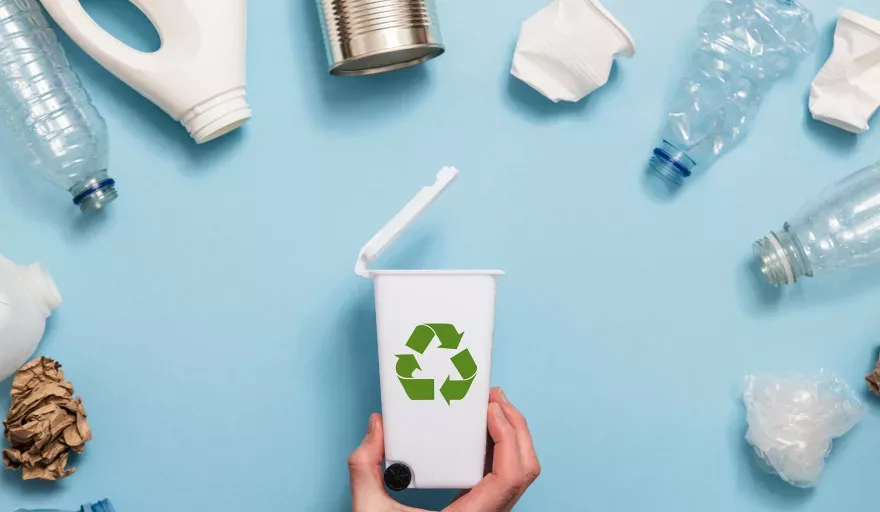Chutima Saengow, Communications Manager for Southeast Asia and Pacific at leading services solutions provider Sidel, explores the role of PET plastic in overcoming the sustainability challenge.
PACKING IS A RESOURCE, NOT A WASTE
The packaging industry – like every one of us – has to face up to climate change, pollution and scarcity. What are the challenges and how can we make our future more sustainable?
By far the biggest contributor to global warming – at more than 73 percent! – is energy consumption. Reducing energy use should be every organisation’s priority. It is certainly high on the agenda in the packaging industry.
According to Climate Collaborative, on average, packaging accounts for about five percent of the energy used in the life cycle of a food product, making it a significant source of GHG emissions.
Marine waste is another huge environmental problem. The United Nations Environmental Programme (UNEP) has found that 90 percent of litter in our oceans is made up of different plastic polymers. Packaging makes up just eight percent of that total, but our industry is now moving more quickly to address this issue.
The world must also confront water scarcity. By 2025, up to 3.5 billion people might be living in areas of water stress. Without a developed water infrastructure, the only way to get them drinkable water will be by using packaging in one form or another.
So, how is the packaging industry stepping up to these challenges? By making a drastic shift from a linear to a circular economy model. We need to acknowledge that packaging is a resource, not a waste.
By keeping it in the circular economy loop, PET plastic packaging can play a pivotal role in protecting and distributing our most precious products. This has been recognised by the Ellen MacArthur Foundation through its New Plastics Economy Global Commitment, in which Sidel is one of the signatories.
ENERGY INNOVATION
As a major supplier of packaging equipment and services, we’re working hard to help the beverage industry to become more sustainable. We’ve committed to making a bold shift to using green energy on our own production sites and are engaging with our suppliers on their sustainability journey. We committed to cut our own carbon emissions (known as Scope 1 and 2) by 30 percent by 2030 as well as help our suppliers and customers reduce theirs (Scope 3) by 25 percent in the same timeframe. We’re at our customers’ side. For example, we helped UAE-based customer Zulal make energy savings of 56 percent by moving to a new fully integrated packaging line configuration. New technology, such as our Evo-On Eco app, is enabling our customers to monitor production line energy consumption and make adjustments in real time.
IMPROVING THE CARBON FOOTPRINT OF PET
Lifecycle analysis (LCA), the only scientific way to compare one material with another, shows that plastic, and PET in particular, has the best carbon footprint among materials currently available.
We are continuously working to improve packaging footprint, by following the five principles of reduce, reuse, recycle, replace and reinvent. Our new moulding technology reduces the weight of bottles, cutting down on material use as well as transport emissions.
We are providing tethered caps that stay attached to the bottle, minimising litter ahead of new European legislation. Additionally, we are leading the way in making PET bottles safely refillable, and ensuring best quality bottles even with high quantities of recycled PET.
We are also designing out waste in how bottles are labelled and packaged ready for transportation. As for reinventing, we’re actively scouting for new bio-sourced/bio-based materials.
MANAGING GROWTH SUSTAINABLY
We have to find these new sustainable solutions, because like it or not, plastic packaging is with us in the near term. Sales of packaged products in food, beverages, home and personal care are continuing to grow, especially in the APAC region. The Middle East, Africa and India are driving 4.4 percent compound annual growth in these products by 2024. The use of PET is expected to grow at 1.7 percent with packaged water leading the way with a growth of 4.2 percent. Energy drinks are performing particularly strongly in Asia. So, how can we make this future growth more sustainable?
- Reuse will come to the fore, as the industry comes up with new solutions in the different reuse schemes such as refill-on-the-go, refill-at-home, return-on-the-go and return-from-home.
- Recycled PET will become more prevalent, with the main challenges being availability, quality and price.
- New sustainable materials and easier-to-recycle solutions moving from many layers of multiple materials to one single mono-material layer, will be on the rise.
- The way goods are packaged for transport will be very different.
- Cooperation is key
We are likely to see much more cooperation between manufacturers, brand, suppliers, NGOs and, of course, end consumers. Manufacturers will be expected to take on more responsibility for waste management.
More countries will be joining the 63 nations which have already enacted Extended Producer Responsibility measures, such as product takeback schemes, deposit-refund, and waste collection and takeback guarantees. More governments will fund and create better recycling infrastructures, as well as easier, incentivised ways for consumers to recycle, such as reverse vending machines.
It will take all of these efforts to see significant improvements. If it is properly collected and recycled, PET, far from being the problem, can offer the best answer to the current sustainability challenge. By working together, we can make a true circular economy of plastics possible.




































